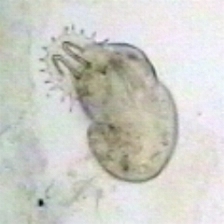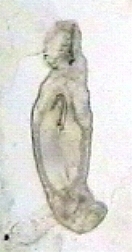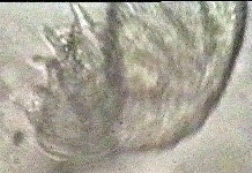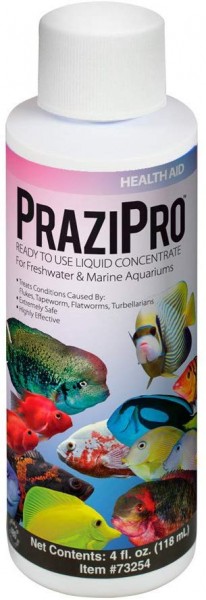Skin flukes (Gyrodactylus ) and gill flukes (Dactylogyrus ) and fish health
Skin and gill flukes are common fish parasites and in small numbers probably cause little harm. In large numbers both skin and gill flukes represent a serious threat to fish health. Flukes can cause lesions and tissue damage as well as producing side affects such as hyperplasia of both skin and gill epithelium and creating entry sites for secondary infections.
The connection between flukes and bacterial fish diseases such as ulcers is well established. Although Gyrodactylus and Dactylogyrus are classed as skin and gill flukes respectively, they are not exclusive to these areas and flukes of either persuasion may be found at either site.
What are flukes?
Flukes are small worm-like parasites up to 2mm in length. Technically they are monogenean trematodes, which describes their biological classification (trematodes) and the fact they only need one host to complete their life cycle (monogenean) whereas many parasitic trematodes need two or more hosts and are thus digeneans!
Skin Flukes (Gyrodactylus) |
|
 |
Skin fluke, Gyrodactylus, showing the array of hooks on its opisthohaptor. It uses these to cling to the fish and move around in a jerking fashion |
 |
The same parasite showing a developing embryo already armed with hooks! |
 |
A fish’s view of that fearsome opisthohaptor. The hooks can cause tissue damage and lead to secondary infections |
|
photos: Frank Prince-Iles |
|
Flukes have an array of hooks at one end of their body which they use to anchor themselves to the fish and to move around in a jerky, caterpillar-like fashion. These hooks can be seen clearly in the photos on the above. The gyrodactylids differ from dactylogyrids in that Gyrodactylus has a v-shaped head, no eyespots and is viviparous (live-bearing), whereas Dactylogyrus has a scalloped head, distinct eyespots and is oviparous (egg-laying).
Cause and reproduction of flukes
It is generally agreed that heavy fluke infestations affecting more than one fish are usually caused by overcrowding, poor water quality or polluted water – that is water with a high organic content and stress. Under ideal circumstances, these parasites can rapidly multiply.
The photo above show a gyrodactylid embryo virtually fully formed inside its mother- however, the baby of that yet unborn fluke is already forming. With this head start – three generations in one – the doubling time for Gyrodactylus can be as little as 24-hours! It is much the same with dactylogyrids, which, in warm water and ideal conditions can reproduce very rapidly and quickly overwhelm any sick or stressed fish.
Damage and diagnosis
The fish response to the irritation caused by flukes is similar to any other irritant, whether it is parasites or chemical. Initially there will be rubbing and flashing. As the disease reaches a more advanced stage the fish will become lethargic – which is the point when some people think the problem has gone away. At a very advanced stage the fish will isolate itself and spend long periods laying on the bottom with its fins clamped to its body. Other signs may be skin cloudiness resulting from excess mucus production, skin hyperplasia, or focal reddening. A definite diagnosis can only be made via a skin scrape or gill biopsy. In large numbers, flukes will kill fish either directly, or indirectly through secondary infections.
Treatments
Right from the start let me say that in many cases flukes are hard to treat and complete eradication is virtually impossible. For individuals affected with flukes, consecutive salt baths over 2-3 days can be useful. Using a quaternary ammonium compound in conjunction with, but not at the same time as, salt baths can be useful, in both clearing the skin and gills of excess mucus and debris as well as soothing damaged tissues.
Malachite and formalin is often effective, although my experience is that the stronger dose needs to be used. It most cases, where the flukes are a nuisance rather than a real danger the old M&F will probably suffice.
For all out war, the best treatments are organophosphates such as masoten. <= LEGACY RECOMMENDATION @ 2019
The best treatment for Flukes of either species is PRAZIQUANTEL which, since this original writing has come into line cost-wise. 2 ounces of Prazi-Pro will treat 200 gallons of water. Usually only one treatment is needed but two doses four days apart are my recommendation.

One ounce per 100 gallons applied twice, 4 days apart will control Flukes of both species. Shake this product extremely well.
Another promising treatment is high dose, bath treatments with chloramine-T. A few trials I have carried out show that in most cases chloramine-T is quite effective, but it is early days to draw any firm conclusions. The draw-back of bath treatments is that it does mean handling the fish and having a large treatment tank. Due to the complications of using chloramine-T in a typical pond, it is unlikely to be so successful as a pond treatment. Bath treatments also allow the life phases which exist in the ponds (eggs and embryos) to continue to survive. Your freshly “cleaned” individual fish will be returned to a pond with emerging stages in it!
Whilst, with enough determination, beating skin flukes is relatively easy, however, the same can’t always be said for gill flukes. Because of gill hyperplasia and increased mucus, the gill-dwellers are often afforded a high degree of protection from chemical treatments. I have had several experiences of flukes surviving multiple treatments safely ensconced in the gill. In such a situation the outlook for the fish is poor, because in addition to the gill flukes there will almost certainly be other gill damage and gill disease.
The most important step in preventing a serious fluke or indeed any parasite problem is first to investigate abnormal behaviour – that is incessant rubbing and flashing or lethargy. Take a scrape and see what’s going on. Don’t just say “parasites” and dump some chemical into the water. It is important to know what you’re dealing with and how severe the problem is. In severe cases it is important to do a follow up at the end of the treatment to see how effective it has been. How severe is severe? One or two flukes in a mucus sample is not abnormal. Any more than that definitely warrants treatment.

